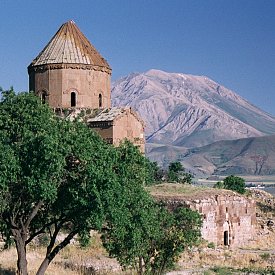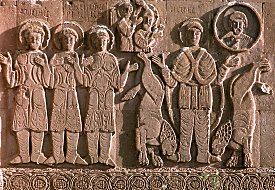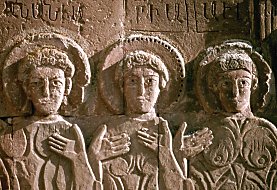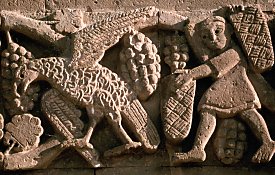


Zone A
This is the lowest band of reliefs, and is also the main one. It consists of a sequence of large-scale figures, mostly human but with some animals. The majority of the subjects are religious in nature but some are of mythical creatures.
They are carved in bas-relief and project 8 to 10cm from the surface of the wall. Many of these reliefs were once coloured: there are still traces of colour on some of them. They also once had eyes of glass or semi-precious stone.
Davis says of the human subjects "of the 61 different individuals, at least 41 come from the Old and New Testaments. Thirty-eight have names inscribed beside or above them, but this leaves 23 who have no identification attached". However, even the identification inscriptions are not entirely reliable since many may have been added at a later date.
The prominent depictions of many ancestral members of the Artzruni dynasty reveal that the construction of this church was as much a political act as a religious act. This is seen most graphically on the west fašade, where King Gagik is portrayed as being taller than Christ.
Zone B
This consists of a row of protruding animal heads and figures (real and mythical) that are carved in high relief.
Zone C
This is known as the vine-scroll frieze. It seems to contain only secular subjects, and mostly rural scenes. Scenes of the grape harvest are interspersed with episodes of daily life (hunting, wrestling, tilling the soil, protecting crops, and so on). The humans depicted are mostly peasants, but the frieze culminates on the east facade with a banqueting scene from courtly life.
Zone D
This includes the reliefs that are carved on the cornice beneath the eaves of the roof. They mostly consist of animals. It also includes the large bas-relief carvings of an Evangelist located at the apex of each of the four gables.
Zone E
The frieze of running animals carved on the cornice that runs around the drum at the base of the conical roof.
Zone F
All the architectural features such as the carvings on the door lintels, the hooded mouldings over the windows, the band of horseshoe mouldings around the base of the drum, etc.

Main Sources:
DAA = Sirarpie Der Nersessian and H. Vahramian, Documents of Armenian Architecture, Volume 8, Aght'amar, Milan, 1974.
Davis = J. G. Davis, Medieval Armenian Art and Architecture: The Church of the Holy Cross, Aght'amar, London, 1991.
Mnatsakanian = Stepan Mnatsakanian, Aghtamar, The Church of the Holy Cross, New Jersey, 1986.
Nersessian = Sirarpie Der Nersessian, Aght'amar, Church of the Holy Cross, Cambridge, Mass., 1964.
Other Sources:
Walter Bachmann, Kirchen und Moscheen in Armenien und Kurdistan, Leipzig, 1913.
Mazhar Şevket İpşiroğlu, Ahtamar Kilisesi, Istanbul, 2003. (This is a Turkish edition of Die Kirche von Achthamar, Berlin, 1963.)
Austin H. Layard, Discoveries in the Ruins of Nineveh and Babylon, London, 1853.
Henry F. B. Lynch, Armenia, Travels and Studies, London, 1901.
Gönül Öney, The Church of Akdamar, Ankara, 1990.
K. Otto-Dorn, Turkish Islamishes Bildgut in den Figurenreliefs von Achthamar, in Anatolica, vol. 6, 1961: pages 99-167.
The drawing is derived from one in "Documents of Armenian Architecture, Volume 8, Aght'amar".